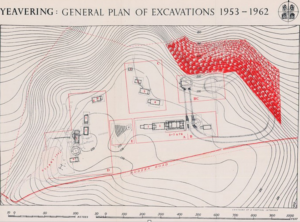Excavations 1953 - 1962
Among the many archaeologists who have left an indelible mark on the field, Brian Hope-Taylor stands as a luminary figure, celebrated for his groundbreaking excavations at Yeavering, an ancient site that provides crucial insights into early Mediaeval history. His meticulous work at Yeavering has not only reshaped our understanding of this period but also set a precedent for archaeological methodology.
Hope-Taylor unearthed a wealth of knowledge about early Mediaeval life and challenged established narratives. His legacy continues to inspire archaeologists to explore, question, and reevaluate our understanding of history.
Methodology and Innovation
 Hope-Taylor’s approach to archaeology was characterised by his attention to detail and commitment to meticulous excavation techniques. His excavation methods were revolutionary for his time, as he prioritised a stratigraphic approach – carefully excavating layer by layer to understand the chronology of the site. This methodology enabled him to unravel the complex history of Yeavering and piece together the story of its evolution.
Hope-Taylor’s approach to archaeology was characterised by his attention to detail and commitment to meticulous excavation techniques. His excavation methods were revolutionary for his time, as he prioritised a stratigraphic approach – carefully excavating layer by layer to understand the chronology of the site. This methodology enabled him to unravel the complex history of Yeavering and piece together the story of its evolution.
One of his most significant contributions was his investigation of timber buildings at Yeavering. His careful recording of these structures provided crucial evidence about the architectural techniques, construction methods, and lifestyle of the Anglo-Saxons. Moreover, he uncovered evidence of metalworking, farming, and trade activities, giving us a vivid snapshot of the community’s multifaceted activities.
Yeavering as a Royal Site
Perhaps the most groundbreaking revelation from Hope-Taylor’s excavations was the identification of Yeavering as a royal palace complex. His work unveiled the presence of grand halls, workshops, and defensive structures, all indicative of a high-status settlement. Yeavering suggested the existence of organised and centralised centres of power.
Legacy and Impact
 Brian Hope-Taylor’s excavations at Yeavering have left an enduring impact on the field of archaeology. His innovative methods, rigorous documentation, and groundbreaking interpretations set new standards for archaeological practice. His ability to contextualize artefacts within the broader historical, social, and economic framework transformed how we approach the study of ancient societies.
Brian Hope-Taylor’s excavations at Yeavering have left an enduring impact on the field of archaeology. His innovative methods, rigorous documentation, and groundbreaking interpretations set new standards for archaeological practice. His ability to contextualize artefacts within the broader historical, social, and economic framework transformed how we approach the study of ancient societies.
Furthermore, Hope-Taylor’s findings have continued to shape our understanding of early Mediaeval Britain. Yeavering’s identification as a royal complex challenged preconceived notions about the political landscape of the time, and it opened up new avenues of research into the structures of power and authority in Anglo-Saxon society.
